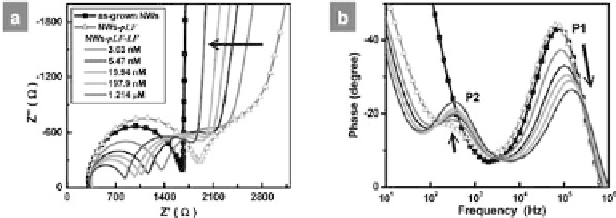Biology Reference
In-Depth Information
dissolved in nitric acid and the silver ion solution was transferred
to a screen-printed carbon electrode for potentiometric stripping
analysis yielding a highly linear response (current peak area) with
DNA concentration and a detection limit
∼
100 ng/mL.
14.3.4
Electrochemical Impedance Spectroscopy at
Nanowires for DNA Detection
Electrochemical Impedance Spectroscopy (EIS) is a method used to
characterizeelectron-transferreactionsbyperturbingthesystemin
a sinusoidal manner over a wide range of frequencies. This method,
which is very sensitive to the properties of the electrode interface,
provides information regarding electron-transfer kinetics, diffusion
of charged species, charging/discharging, and system conductance.
Very recently Chen and coworkers [56] demonstrated the use
of EIS for label-free electrochemical detection of DNA sequences
relevanttoanthraxlethalfactorongalliumnitride(GaN)nanowires.
The GaN nanowires were grown on a silicon substrate coated with
Au catalyst using Ga as the source material and NH
3
as the reactant
gas in a tubular furnace via air pressure chemical vapor deposition.
EIS measurements of the “as grown” GaN nanowires, observed in
the Nyquist plot in Fig. 14.12A, exhibited a semicircle and a straight
vertical line, indicative of finite impedance at the GaN/electrolyte
Figure 14.12.
Electrochemical impedance spectroscopy based
in situ
DNA sensing: (A) Nyquist plots and (B) corresponding Bode plots of as
grown,DNAprobeagainstanthraxlethalfactor(pLF)-modified,anddsDNA-
modifiedGaNNWsatdifferentconcentrationsofLFtargets(arrowsindicate
increasing concentration,
in situ
DNAhybridization detection).









